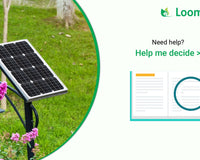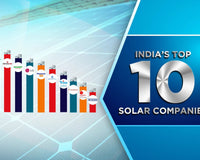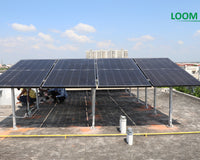The Government of India has set an ambitious target of installation of Grid Connected Rooftop Solar Photovoltaic (GC-RSPV) projects with capacity aggregating 40 GW out of total incremental target of 175 GW of Renewable Energy capacity by 2022. With a view to giving a fillip to this segment, SBI has availed a line of credit from World Bank specifically, for financing Grid Connected Rooftop Solar Photovoltaic projects across the country through its identified branches (refer Annexure I). A Customized financial product has been developed by SBI and benchmark parameters for the purpose drawn up. The benchmark parameters and terms & conditions under the program are as under:
| Sr. No. | Parameter | Details |
| 1. | Eligibility Criteria | Sole Proprietorship, Partnership Firm/ including LLP and Company/ Special Purpose Vehicle (SPV)/ NBFC Borrower or their parent company/ sponsor should have: (i) at least 1 year experience/ past track record in power sector, and (ii) CRA rating of SB-10 & better and/or ECR of Investment grade. |
| 2. | Branches identified for handling this business |
All Corporate Account Group Branches (Project debt component above Rs 500 cr.), Commercial Clients Group Branches (Project debt component above Rs 50 cr. and up to Rs 500 cr.), and |
| 3. | Loan amount | Up to 75% of project cost. |
| 4. | Type of Facility | i) Term Loan ii) Need based Working Capital against receivables iii) Need based NFB (LC/BG) facility |
| 5. | Pricing |
➢Six months Marginal Cost of Funds Based Lending Rate (MCLR) plus spread in the range of 120 bps to 190 bps based on risk rating of the customer ➢ Loans extended to MSMEs will be linked to external benchmark rate as per Bank’s extant guidelines plus spread in the range of 120 bps to 190 bps based on risk rating of the customer |
| 6. | Fixed Asset Coverage Ratio (FACR) | 1.10 (minimum) throughout the tenure of the loan |
| 7. | DSCR (at Borrower and also at Individual projects level) | Avg Gross DSCR at P90 : 1.20 |
| 8. | Interest Coverage Ratio (at Borrower and also at Individual project level) |
Minimum – 1.5 |
| 9. | Net Long Term Debt / EBITDA ) (at borrower and also at Individual sub-project level) |
i) 6.2:1 for initial 3 years. ii) Below 6 from 4th year onwards |
| 10. | Loan Repayment Period (Maximum) | Door to Door tenor up to 15 years. |
| 11. | Moratorium | Up to 12 months post Date of Commencement of Commercial Operations (DCCO). |
| 12. | Primary Security | ➢ Exclusive first charge on all fixed assets, movable assets, and current assets, lease hold rights, cash flows and project related accounts & rights therein, current as well as future relating to the project (T & C applicable). ➢ Assignment of Project documents. |
| 13. | Collateral Security | The Bank may seek additional security (Collateral) if FACR falls below 1.10 |
| 14. | Guarantee | i) In case of Sole Proprietorship /Partnership Firm/ Company, personal guarantee of proprietor/ partners/ directors. ii) In case of Special Purpose Vehicles (SPVs)/ Associates/ Subsidiaries, Corporate Guarantee of sponsor can be further explored. |
| 15. | Debt Service Reserve Account (DSRA) | Minimum Level :Equivalent to 6 months principal and interest. |
| 16. | Statutory Clearances & PPA | The required project agreements (including PPA)/ clearances/ approvals (as applicable) should be in place, before disbursement of 1st tranche for each individual loan under the overall sanctioned credit facility. |
| 17. | Others | Mandatory compliance of World Bank guidelines on procurement and Environment, Health, Safety and Social (EHSS) related to rooftop solar projects. |
Illustrative list of information required to be furnished by the applicant:
➢ ID and address proof of the applicant and guarantors, if any. E.g. voter ID, PAN no. voter ID, Aadhar No, MOA, AOA etc.).
➢ Income tax return, Wealth Tax Returns of the applicant and guarantors for the past three financial years.
➢ Annual Report consisting Audited balance Sheets with Trading & Profit & Loss Account, for the last three years of the applicant and associates of the applicant.
➢ Memorandum and Articles of Association, Certificate of Commencement of Business in case applicant is a Company.
➢ GST Returns for the last three years.
➢ Copy of DPR (Detailed Project Report) along with Projected Balance Sheet, Profit & Loss Account and Cash Flow Statement with assumptions made /TEV (Technical Evaluation) study of the
Note: Benchmarks parameters and terms and conditions as mentioned above are indicative and not exhaustive. The Bank always reserves the right to modify/ change as and when deemed necessary.
Download SBI – WORLD BANK: GRID CONNECTED ROOFTOP SOLAR PV PROGRAM
Types of loans offered by SBI
Home Loan: It becomes difficult for our pockets if we want to do a big investment of buying a new house, getting our home renovated, buying a new gadget, or going on a trip. For such big expenses, we can get financial assistance from banks as loans against guarantee or collateral.
SBI provides home loans at affordable interest rates to all its customers. Also, it has different schemes for home loans like the shaurya scheme and government schemes.
Consumer Durable Loan (Loan for Renovation): SBI offers consumer durable loans to renovate, upgrade or add value to your existing house. You can take this loan against any security at the interest rates offered by SBI. The repayments period for such a loan is up to 2 years.
Gold Loan: SBI offers a loan against your gold where the gold is kept as collateral and an amount in accordance to the value of your gold is offered to you as a loan.
Education Loan: SBI gives education loans to deserving students for taking admission in various colleges or universities.
Auto Loan: Under this loan scheme, the bank offers two-wheeler loans, car loans, and bike loans at affordable interest rates to its customers.
Purpose of taking a loan from SBI:
We all manage our daily and monthly expenses by planning our budget. The loan is a financial help you can get from a bank against any security at a pre-decided interest rate for a specified period of time. Banks ask you a very important question when you ask them for a loan. This is the purpose of taking that loan.
Through this article, we will throw light on the two most important purposes of taking loans. You will be able to note the important factors you need to take care of while taking a home loan or a consumer durable loan.
Buy a New house – If you are taking out a loan for buying a property, you have to give them a brief description of the kind of property it is. Banks keep your purchased property as a security against your home loan. Thus, they want to know if you are buying an independent house, an apartment, a plot, or a villa.
Upgrade existing house – A consumer durable loan will help you to upgrade your existing house as it provides you funds to get new gadgets, appliances, to add to your house or renovate your house. You can even modernize your kitchen or living room.
Who is eligible to apply for PM Surya Ghar Muft Bijli Yojana
According to Press Information Bureau (PIB) release issued on March 1, 2024:
- The applicant must be an Indian citizen.
- Must own a house with a roof that is suitable for installing solar panels.
- The household must have a valid electricity connection.
- The household must not have availed of any other subsidy for solar panels.
How much loan can I get?
When you plan to buy a new house and go to a bank to apply for a home loan. You all need to know the maximum amount you can get as a home loan. The amount of home loans that the bank can provide you will mainly depend upon your monthly salary. The rate of interest of your loan and their repayment tenure will also play an important role in deciding the quantum of your loan.
What is kept as a Security for a home loan and what is its margin?
The LTV ratio (loan to value ratio) is the amount of loan offered by the bank with respect to the value of the property that you are buying. SBI usually offers 80% to 90% as the LTV.
As far as security against a home loan is concerned, the property purchased itself is considered as the security for that loan. If due to any reason, the borrower is not able to pay the EMI’s for a long time, the bank can sell the same property.
What is the tenure to pay the home loan?
The tenure of the repayment period of the home loan lies between 1 year to 30 years. The applicant can choose the repayment tenure as per their capability and divide the loan into EMIs accordingly.
Forms and documents to be filled to apply for a home loan?
To apply for a home loan in SBI, you have to get ready with the following documents of the applicant as well as the co-applicant:
- SBI loan application form along with 3 photographs of the applicant
- Any one proof of Identity (Passport/ PAN/ Driver’s license/ Voter ID)
- Any one proof of residence
- Documents related to the proof of purchase of property
- Bank account statement of all bank accounts held by the applicant
- Proof of Income in case of a salaried applicant in the form of a salary slip
- In the case of businessmen, the profit and loss A/C for the last 3 years is considered
- Professionals like doctor and CA needs to submit the certificate of qualification
What is the interest rate of home loans in SBI?
All banks charge different interest rates for home loans. Interest rates vary as per the risk score or the CIBIL score of the customer. LTV ratio is also an important factor that determines the rate of interest charged by the banks.
Home loan festive rates of SBI home loans up to 31-12-21 range between 6.70%- 6.90%(Terms and Conditions apply).
What are the processing charges at SBI?
For all the approved projects, SBI doesn’t charge any processing fees whereas, for the unapproved projects, only out-of-pocket expenses or actual charges incurred by the bank are liable to be recovered.
SBI facilities to its borrowers:
SBI has easy policies regarding foreclosure, transfer of surrendering of existing home loans. SBI provides good after-sales services to its borrowers to maximize their satisfaction.
Why take a home loan and buy a home with Solar?
The world is upgrading every day with improving technology. The real estate industry of India is planning to introduce homes with solar power plants installed which will help the buyer to save their lifetime electricity bill without much trouble.
Also, the banks will soon come up with ideas to provide home loans for homes with solar. This means you can get a house with a solar power plant installed at the same rate of interest in which you get a home loan.
Conclusion
A home with solar technology is a very beneficial option if you are planning to buy a new house. We all think that electricity bills are a huge burden on the pockets of a middle-class person. With the solar power plant installed in your own house, you will save approximately Rs. 1 lakh annually on your electricity bill and also contribute to a better environment.
Solar manufacturing companies like Loom Solar are working hand-to-hand with the real estate industry to get the home solar-ready for the coming years. You can get more information about the use and importance of solar products on the official website of loom solar.













1 comment
RIYAJ husshan Mansuri
10kw ongrid solar system on loan and emi